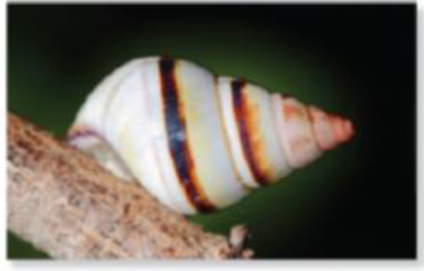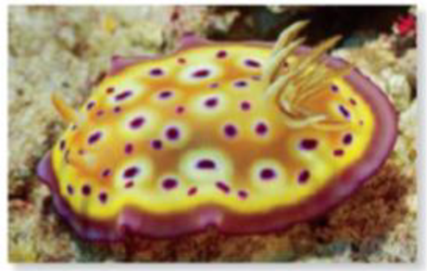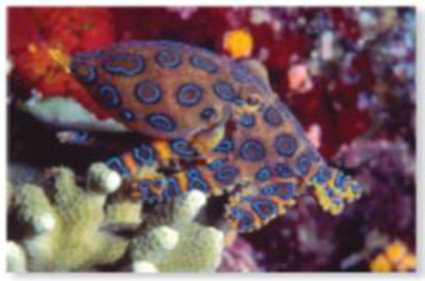
Concept explainers

(a) A quahog clam, cless Bavalvia

(b) A chlton, class Polyplacophora

(c) A snail, class Gastropoda

(d) A nudbranch, class Gastropoda

(e) A blue-ringed octopus, class Cephalopodan
Figure 34.12 Mollusks. (a) A bivalve shell, class Bivalvia, with growth rings. This quahog clam (Mercenaria mercenaria) can live over 20 years. (b) A chiton (Tonicella lineata), a polyplacophoran with a shell made up of eight separate plates. (c) A gastropod, the tree snail, Liguus fasciatus, from the Florida Everglades showing its characteristic coiled shell. (d) A nudibranch (Phyllidia ocellata). The nudibranchs are a gastropod subclass whose members have lost their shell altogether. (e) The highly poisonous blue-ringed octopus (Hapalochlaena lunulata), a cephalopod.
Core Skill: Connections Refer back to Figure 34.12. Which types of antipredator adaptations are possessed by mollusks?
Want to see the full answer?
Check out a sample textbook solution
Chapter 57 Solutions
Biology
- Closest to Chordata 1. Echinodermata2. Platyhelminthes3. Annelida4. Porifera5. Chordata6. Arthropoda7. Nematods8. Cnidaria9. Molluscaarrow_forwardanimals in which of the following classes possess adductor muscles, labial palps, and use their gills for both respiration and feeding? -Bivalvia -Cephalopoda -Polyplacophora -Anthozoa -Gastropodaarrow_forwardFirst with body segmentation 1. Echinodermata2. Platyhelminthes3. Annelida4. Porifera5. Chordata6. Arthropoda7. Nematods8. Cnidaria9. Molluscaarrow_forward
- While collecting specimens, a marine biologist finds a sessile Cnidarian. The medusas that bud from it swim by contracting a ring of muscle in their bells. To which class does this specimen belong? Class Hydrozoa Class Cubozoa Class Scyphozoa Class Anthozoaarrow_forwardFigure 27.6 Which of the following statements is false? Eumetazoans have specialized tissues and parazoans don’t. Lophotrochozoa and Ecdysozoa are both Bilataria. Acoela and Cnidaria both possess radial symmetry. Arthropods are more closely related to nematodes than they are to annelids.arrow_forwardA mantle and mantle cavity are present in: phylum Echinodermata phylum Adversoidea phylum Mollusca phylum Nemertea.arrow_forward
- Which phylum includes animals that have a water vascular system? a. Echinodermata b. Hemichordata c. Chordata d. Tetrapoda e. Amniotaarrow_forwardTrilobites (a) were early mollusks (b) are onychophorans (c) are characterized by parapodia and setae (d) were early arthropods (e) are an evolutionary link between annelids and arthropodsarrow_forwardMollusca (clams, abalone, nudibranchs, snails, squid, octopi, etc). Unifying features include shell, mantle, radula, foot, visceral mass Which classes show a loss of the shell. How does the shell benefit an organism, how does the loss of the shell benefit other members of this phylum? Distinguish between polyplacophora, bivalva, gastropoda, and chephalopoda We see the first evolution of a true eye here. Who has it? What are chromatophores? How doe members of this group use them? What other unique defense addaptaions do we see in this group? (warning colors, 2 shells, ink)arrow_forward
- a) List down subclasses of Gastropoda b) Snails are distinguished by an anatomical process known as where the visceral mass of the animals rotates 180° to one side during the development. c) acts as a trapdoor to close the shell. d) How many tentacles do the land snails have? e) What is the function of radula?arrow_forwardA NEOMENIOMORPHA CHAETODERMOMORPHA POLYPLACOPHORA MONOPLACOPHORA B GASTROPODA CEPHALOPODA SCAPHOPODA BIVALVIA Which kind of phyletic group is represented by region A?.arrow_forwardWhich class of Cnidarian is described below: This class includes the corals and the sea anemones. Individual animals are cylindrical in shape and are attached directly to a substrate in the polyp body form. Question 18 options: a) Class Hydrozoa b) Class Scyphozoa c) Class Cubozoa d) Class Anthozoaarrow_forward
 Biology 2eBiologyISBN:9781947172517Author:Matthew Douglas, Jung Choi, Mary Ann ClarkPublisher:OpenStax
Biology 2eBiologyISBN:9781947172517Author:Matthew Douglas, Jung Choi, Mary Ann ClarkPublisher:OpenStax Biology (MindTap Course List)BiologyISBN:9781337392938Author:Eldra Solomon, Charles Martin, Diana W. Martin, Linda R. BergPublisher:Cengage Learning
Biology (MindTap Course List)BiologyISBN:9781337392938Author:Eldra Solomon, Charles Martin, Diana W. Martin, Linda R. BergPublisher:Cengage Learning Biology: The Dynamic Science (MindTap Course List)BiologyISBN:9781305389892Author:Peter J. Russell, Paul E. Hertz, Beverly McMillanPublisher:Cengage Learning
Biology: The Dynamic Science (MindTap Course List)BiologyISBN:9781305389892Author:Peter J. Russell, Paul E. Hertz, Beverly McMillanPublisher:Cengage Learning



